JHSS: Military Supply Chain Challenges & Industry 4.0 Integration
VerifiedAdded on 2023/06/11
|20
|4693
|237
Report
AI Summary
This report investigates the challenges in military supply chains that hinder the implementation of Industry 4.0 within the Joint Helicopter Support Squadron (JHSS), a Royal Logistics Corps unit supporting UK defense missions. The research highlights issues such as a lack of innovation, subpar cybersecurity, and a lack of digitized systems, which impede the adoption of Industry 4.0. The report outlines the benefits of smart supply chains and advanced cyber systems, providing an action plan for JHSS to overcome these challenges through digitization and increased agility. Ethical considerations and recommendations are included to ensure effective implementation and adherence to army values, aiming to modernize JHSS operations and enhance its support to the UK armed forces. Desklib is a platform where you can find similar assignments and study resources.
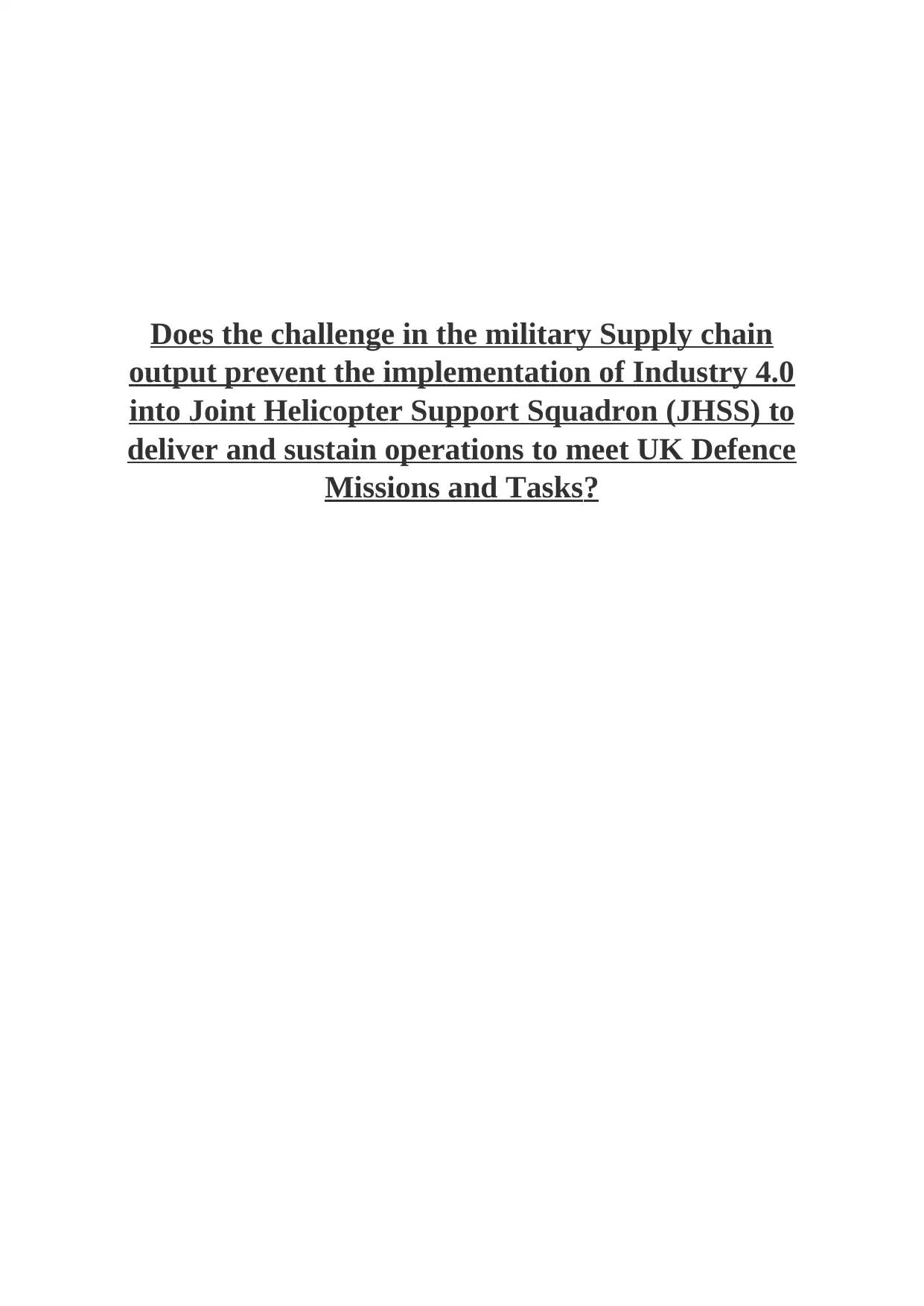
Does the challenge in the military Supply chain
output prevent the implementation of Industry 4.0
into Joint Helicopter Support Squadron (JHSS) to
deliver and sustain operations to meet UK Defence
Missions and Tasks?
output prevent the implementation of Industry 4.0
into Joint Helicopter Support Squadron (JHSS) to
deliver and sustain operations to meet UK Defence
Missions and Tasks?
Paraphrase This Document
Need a fresh take? Get an instant paraphrase of this document with our AI Paraphraser
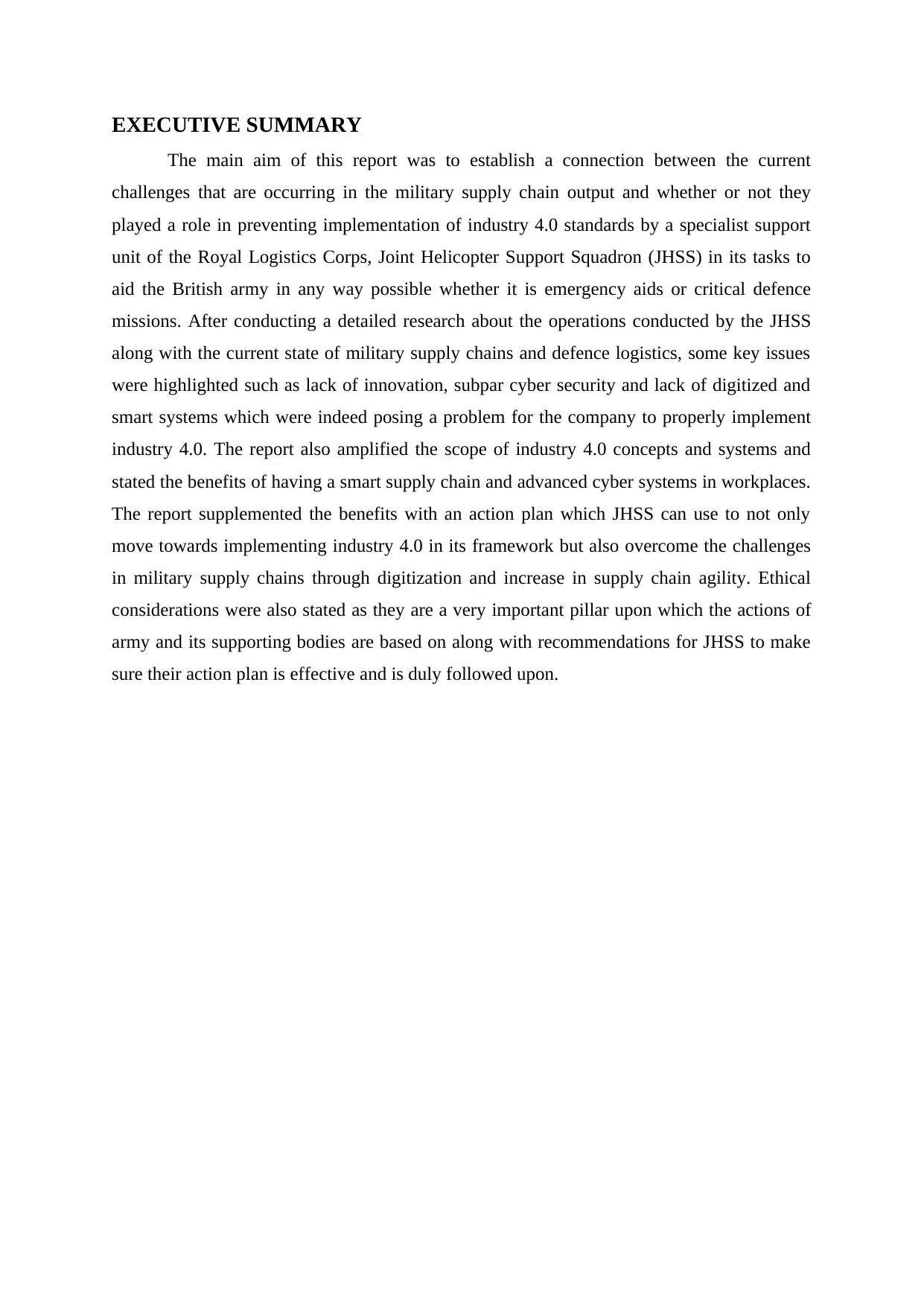
EXECUTIVE SUMMARY
The main aim of this report was to establish a connection between the current
challenges that are occurring in the military supply chain output and whether or not they
played a role in preventing implementation of industry 4.0 standards by a specialist support
unit of the Royal Logistics Corps, Joint Helicopter Support Squadron (JHSS) in its tasks to
aid the British army in any way possible whether it is emergency aids or critical defence
missions. After conducting a detailed research about the operations conducted by the JHSS
along with the current state of military supply chains and defence logistics, some key issues
were highlighted such as lack of innovation, subpar cyber security and lack of digitized and
smart systems which were indeed posing a problem for the company to properly implement
industry 4.0. The report also amplified the scope of industry 4.0 concepts and systems and
stated the benefits of having a smart supply chain and advanced cyber systems in workplaces.
The report supplemented the benefits with an action plan which JHSS can use to not only
move towards implementing industry 4.0 in its framework but also overcome the challenges
in military supply chains through digitization and increase in supply chain agility. Ethical
considerations were also stated as they are a very important pillar upon which the actions of
army and its supporting bodies are based on along with recommendations for JHSS to make
sure their action plan is effective and is duly followed upon.
The main aim of this report was to establish a connection between the current
challenges that are occurring in the military supply chain output and whether or not they
played a role in preventing implementation of industry 4.0 standards by a specialist support
unit of the Royal Logistics Corps, Joint Helicopter Support Squadron (JHSS) in its tasks to
aid the British army in any way possible whether it is emergency aids or critical defence
missions. After conducting a detailed research about the operations conducted by the JHSS
along with the current state of military supply chains and defence logistics, some key issues
were highlighted such as lack of innovation, subpar cyber security and lack of digitized and
smart systems which were indeed posing a problem for the company to properly implement
industry 4.0. The report also amplified the scope of industry 4.0 concepts and systems and
stated the benefits of having a smart supply chain and advanced cyber systems in workplaces.
The report supplemented the benefits with an action plan which JHSS can use to not only
move towards implementing industry 4.0 in its framework but also overcome the challenges
in military supply chains through digitization and increase in supply chain agility. Ethical
considerations were also stated as they are a very important pillar upon which the actions of
army and its supporting bodies are based on along with recommendations for JHSS to make
sure their action plan is effective and is duly followed upon.
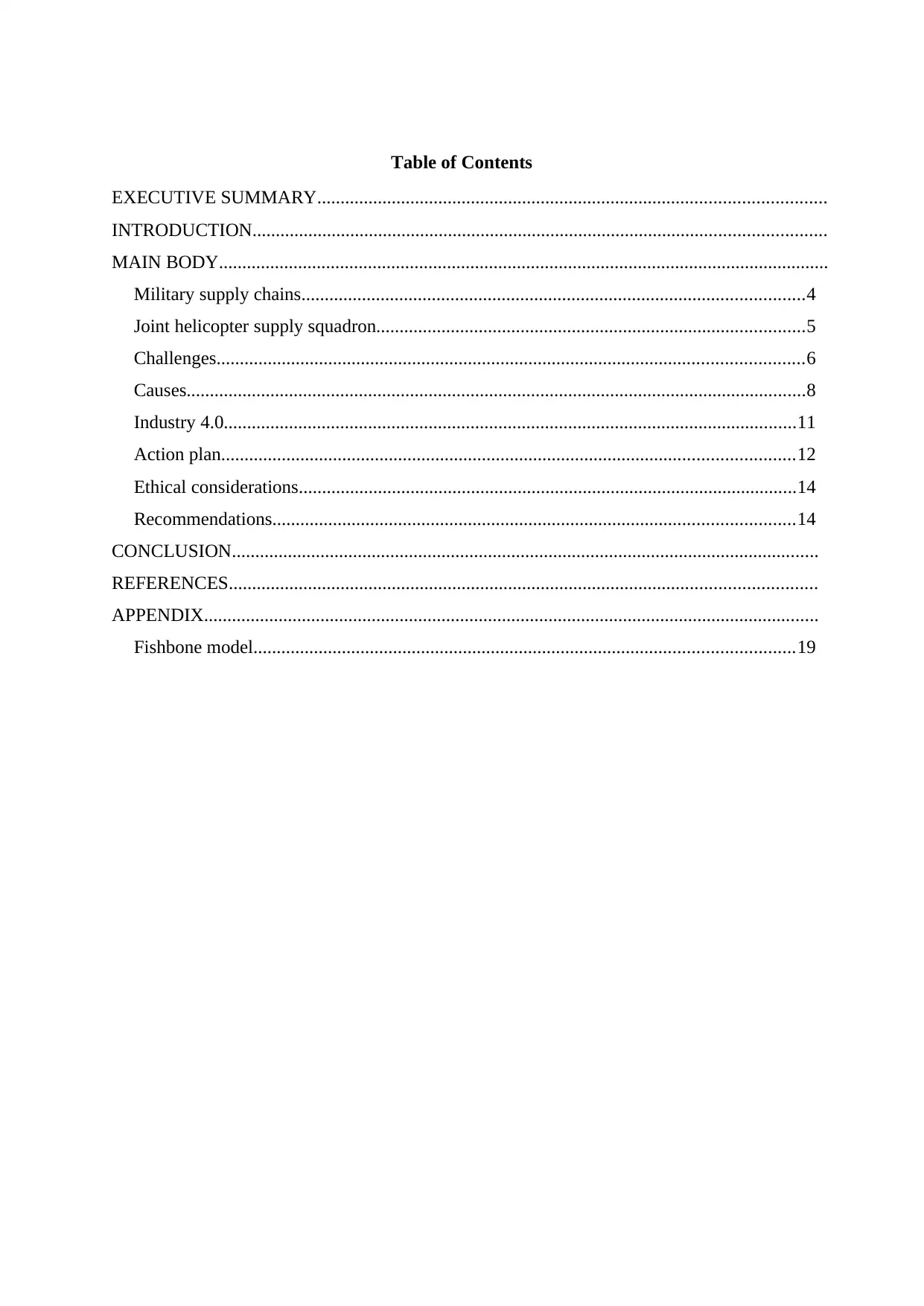
Table of Contents
EXECUTIVE SUMMARY.............................................................................................................
INTRODUCTION...........................................................................................................................
MAIN BODY...................................................................................................................................
Military supply chains............................................................................................................4
Joint helicopter supply squadron............................................................................................5
Challenges..............................................................................................................................6
Causes.....................................................................................................................................8
Industry 4.0...........................................................................................................................11
Action plan...........................................................................................................................12
Ethical considerations...........................................................................................................14
Recommendations................................................................................................................14
CONCLUSION..............................................................................................................................
REFERENCES..............................................................................................................................
APPENDIX....................................................................................................................................
Fishbone model....................................................................................................................19
EXECUTIVE SUMMARY.............................................................................................................
INTRODUCTION...........................................................................................................................
MAIN BODY...................................................................................................................................
Military supply chains............................................................................................................4
Joint helicopter supply squadron............................................................................................5
Challenges..............................................................................................................................6
Causes.....................................................................................................................................8
Industry 4.0...........................................................................................................................11
Action plan...........................................................................................................................12
Ethical considerations...........................................................................................................14
Recommendations................................................................................................................14
CONCLUSION..............................................................................................................................
REFERENCES..............................................................................................................................
APPENDIX....................................................................................................................................
Fishbone model....................................................................................................................19
⊘ This is a preview!⊘
Do you want full access?
Subscribe today to unlock all pages.

Trusted by 1+ million students worldwide
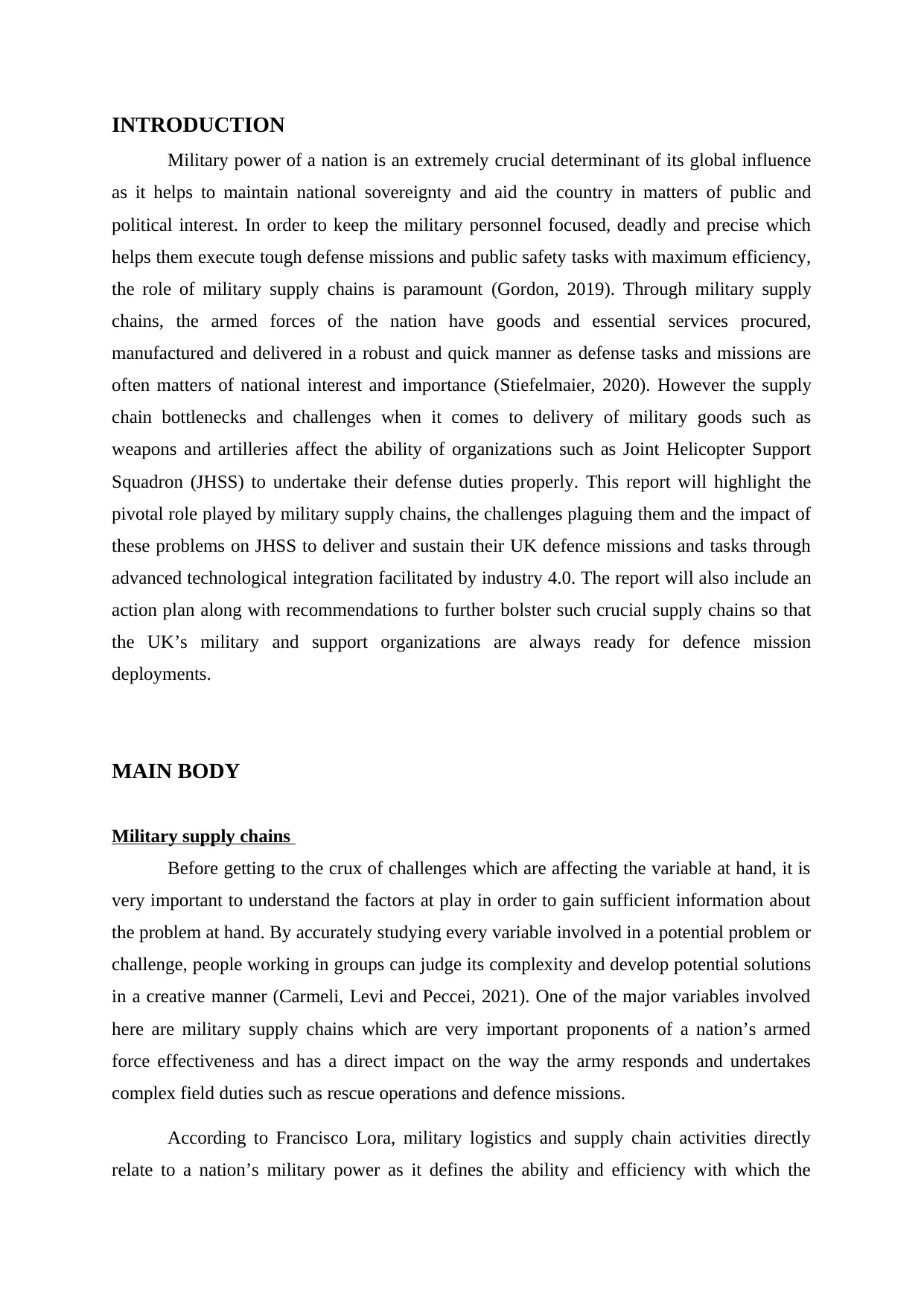
INTRODUCTION
Military power of a nation is an extremely crucial determinant of its global influence
as it helps to maintain national sovereignty and aid the country in matters of public and
political interest. In order to keep the military personnel focused, deadly and precise which
helps them execute tough defense missions and public safety tasks with maximum efficiency,
the role of military supply chains is paramount (Gordon, 2019). Through military supply
chains, the armed forces of the nation have goods and essential services procured,
manufactured and delivered in a robust and quick manner as defense tasks and missions are
often matters of national interest and importance (Stiefelmaier, 2020). However the supply
chain bottlenecks and challenges when it comes to delivery of military goods such as
weapons and artilleries affect the ability of organizations such as Joint Helicopter Support
Squadron (JHSS) to undertake their defense duties properly. This report will highlight the
pivotal role played by military supply chains, the challenges plaguing them and the impact of
these problems on JHSS to deliver and sustain their UK defence missions and tasks through
advanced technological integration facilitated by industry 4.0. The report will also include an
action plan along with recommendations to further bolster such crucial supply chains so that
the UK’s military and support organizations are always ready for defence mission
deployments.
MAIN BODY
Military supply chains
Before getting to the crux of challenges which are affecting the variable at hand, it is
very important to understand the factors at play in order to gain sufficient information about
the problem at hand. By accurately studying every variable involved in a potential problem or
challenge, people working in groups can judge its complexity and develop potential solutions
in a creative manner (Carmeli, Levi and Peccei, 2021). One of the major variables involved
here are military supply chains which are very important proponents of a nation’s armed
force effectiveness and has a direct impact on the way the army responds and undertakes
complex field duties such as rescue operations and defence missions.
According to Francisco Lora, military logistics and supply chain activities directly
relate to a nation’s military power as it defines the ability and efficiency with which the
Military power of a nation is an extremely crucial determinant of its global influence
as it helps to maintain national sovereignty and aid the country in matters of public and
political interest. In order to keep the military personnel focused, deadly and precise which
helps them execute tough defense missions and public safety tasks with maximum efficiency,
the role of military supply chains is paramount (Gordon, 2019). Through military supply
chains, the armed forces of the nation have goods and essential services procured,
manufactured and delivered in a robust and quick manner as defense tasks and missions are
often matters of national interest and importance (Stiefelmaier, 2020). However the supply
chain bottlenecks and challenges when it comes to delivery of military goods such as
weapons and artilleries affect the ability of organizations such as Joint Helicopter Support
Squadron (JHSS) to undertake their defense duties properly. This report will highlight the
pivotal role played by military supply chains, the challenges plaguing them and the impact of
these problems on JHSS to deliver and sustain their UK defence missions and tasks through
advanced technological integration facilitated by industry 4.0. The report will also include an
action plan along with recommendations to further bolster such crucial supply chains so that
the UK’s military and support organizations are always ready for defence mission
deployments.
MAIN BODY
Military supply chains
Before getting to the crux of challenges which are affecting the variable at hand, it is
very important to understand the factors at play in order to gain sufficient information about
the problem at hand. By accurately studying every variable involved in a potential problem or
challenge, people working in groups can judge its complexity and develop potential solutions
in a creative manner (Carmeli, Levi and Peccei, 2021). One of the major variables involved
here are military supply chains which are very important proponents of a nation’s armed
force effectiveness and has a direct impact on the way the army responds and undertakes
complex field duties such as rescue operations and defence missions.
According to Francisco Lora, military logistics and supply chain activities directly
relate to a nation’s military power as it defines the ability and efficiency with which the
Paraphrase This Document
Need a fresh take? Get an instant paraphrase of this document with our AI Paraphraser
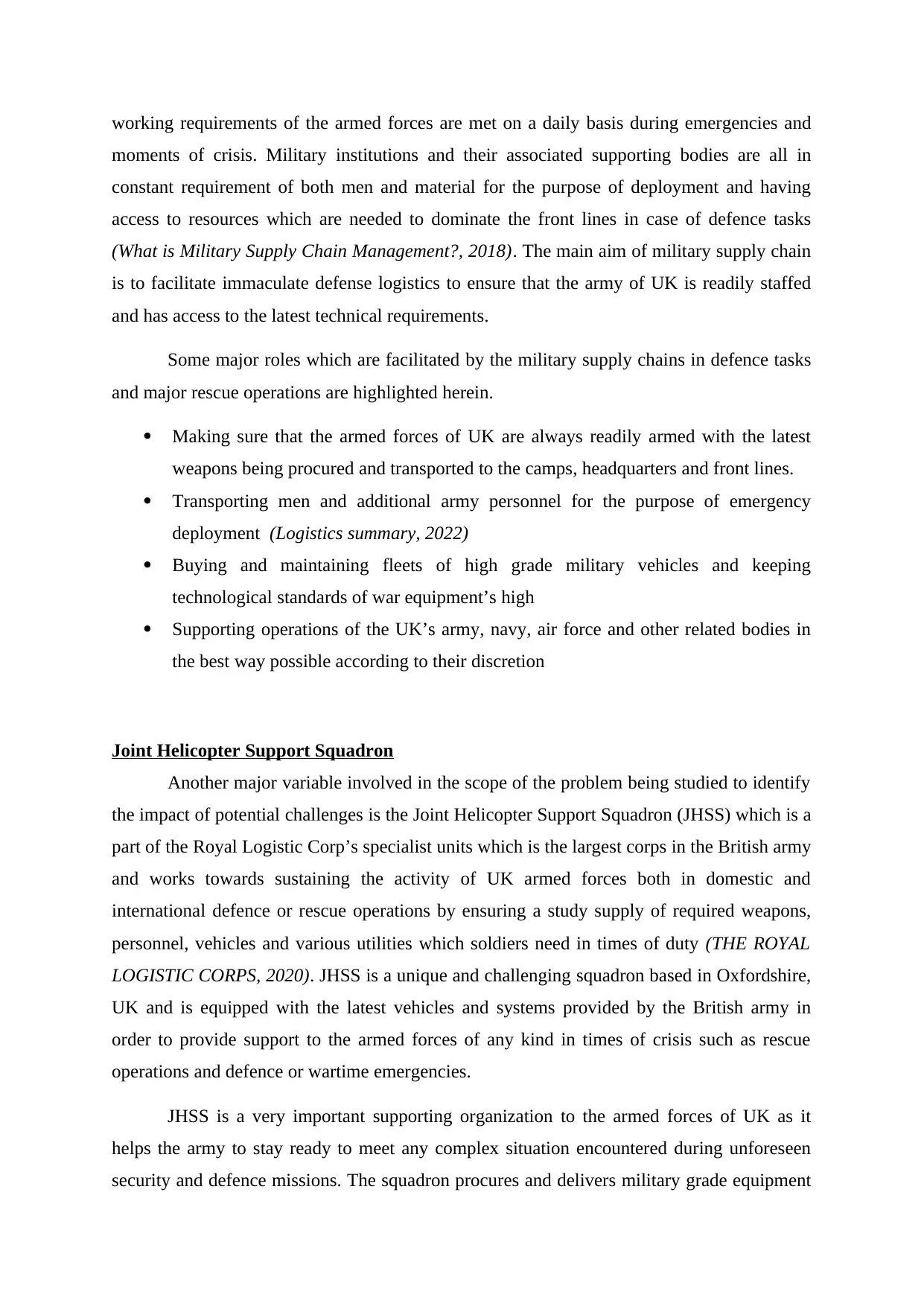
working requirements of the armed forces are met on a daily basis during emergencies and
moments of crisis. Military institutions and their associated supporting bodies are all in
constant requirement of both men and material for the purpose of deployment and having
access to resources which are needed to dominate the front lines in case of defence tasks
(What is Military Supply Chain Management?, 2018). The main aim of military supply chain
is to facilitate immaculate defense logistics to ensure that the army of UK is readily staffed
and has access to the latest technical requirements.
Some major roles which are facilitated by the military supply chains in defence tasks
and major rescue operations are highlighted herein.
Making sure that the armed forces of UK are always readily armed with the latest
weapons being procured and transported to the camps, headquarters and front lines.
Transporting men and additional army personnel for the purpose of emergency
deployment (Logistics summary, 2022)
Buying and maintaining fleets of high grade military vehicles and keeping
technological standards of war equipment’s high
Supporting operations of the UK’s army, navy, air force and other related bodies in
the best way possible according to their discretion
Joint Helicopter Support Squadron
Another major variable involved in the scope of the problem being studied to identify
the impact of potential challenges is the Joint Helicopter Support Squadron (JHSS) which is a
part of the Royal Logistic Corp’s specialist units which is the largest corps in the British army
and works towards sustaining the activity of UK armed forces both in domestic and
international defence or rescue operations by ensuring a study supply of required weapons,
personnel, vehicles and various utilities which soldiers need in times of duty (THE ROYAL
LOGISTIC CORPS, 2020). JHSS is a unique and challenging squadron based in Oxfordshire,
UK and is equipped with the latest vehicles and systems provided by the British army in
order to provide support to the armed forces of any kind in times of crisis such as rescue
operations and defence or wartime emergencies.
JHSS is a very important supporting organization to the armed forces of UK as it
helps the army to stay ready to meet any complex situation encountered during unforeseen
security and defence missions. The squadron procures and delivers military grade equipment
moments of crisis. Military institutions and their associated supporting bodies are all in
constant requirement of both men and material for the purpose of deployment and having
access to resources which are needed to dominate the front lines in case of defence tasks
(What is Military Supply Chain Management?, 2018). The main aim of military supply chain
is to facilitate immaculate defense logistics to ensure that the army of UK is readily staffed
and has access to the latest technical requirements.
Some major roles which are facilitated by the military supply chains in defence tasks
and major rescue operations are highlighted herein.
Making sure that the armed forces of UK are always readily armed with the latest
weapons being procured and transported to the camps, headquarters and front lines.
Transporting men and additional army personnel for the purpose of emergency
deployment (Logistics summary, 2022)
Buying and maintaining fleets of high grade military vehicles and keeping
technological standards of war equipment’s high
Supporting operations of the UK’s army, navy, air force and other related bodies in
the best way possible according to their discretion
Joint Helicopter Support Squadron
Another major variable involved in the scope of the problem being studied to identify
the impact of potential challenges is the Joint Helicopter Support Squadron (JHSS) which is a
part of the Royal Logistic Corp’s specialist units which is the largest corps in the British army
and works towards sustaining the activity of UK armed forces both in domestic and
international defence or rescue operations by ensuring a study supply of required weapons,
personnel, vehicles and various utilities which soldiers need in times of duty (THE ROYAL
LOGISTIC CORPS, 2020). JHSS is a unique and challenging squadron based in Oxfordshire,
UK and is equipped with the latest vehicles and systems provided by the British army in
order to provide support to the armed forces of any kind in times of crisis such as rescue
operations and defence or wartime emergencies.
JHSS is a very important supporting organization to the armed forces of UK as it
helps the army to stay ready to meet any complex situation encountered during unforeseen
security and defence missions. The squadron procures and delivers military grade equipment
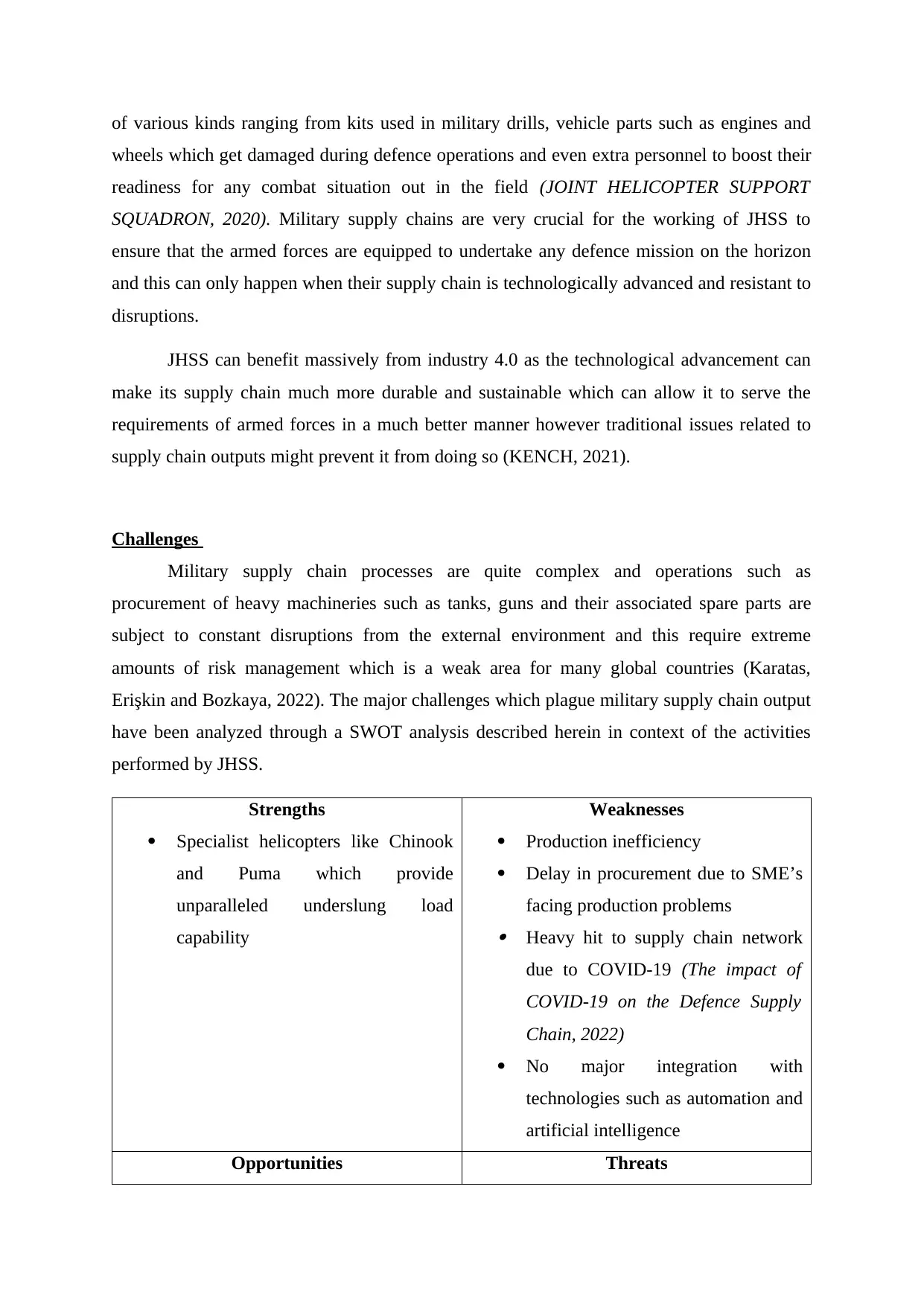
of various kinds ranging from kits used in military drills, vehicle parts such as engines and
wheels which get damaged during defence operations and even extra personnel to boost their
readiness for any combat situation out in the field (JOINT HELICOPTER SUPPORT
SQUADRON, 2020). Military supply chains are very crucial for the working of JHSS to
ensure that the armed forces are equipped to undertake any defence mission on the horizon
and this can only happen when their supply chain is technologically advanced and resistant to
disruptions.
JHSS can benefit massively from industry 4.0 as the technological advancement can
make its supply chain much more durable and sustainable which can allow it to serve the
requirements of armed forces in a much better manner however traditional issues related to
supply chain outputs might prevent it from doing so (KENCH, 2021).
Challenges
Military supply chain processes are quite complex and operations such as
procurement of heavy machineries such as tanks, guns and their associated spare parts are
subject to constant disruptions from the external environment and this require extreme
amounts of risk management which is a weak area for many global countries (Karatas,
Erişkin and Bozkaya, 2022). The major challenges which plague military supply chain output
have been analyzed through a SWOT analysis described herein in context of the activities
performed by JHSS.
Strengths
Specialist helicopters like Chinook
and Puma which provide
unparalleled underslung load
capability
Weaknesses
Production inefficiency
Delay in procurement due to SME’s
facing production problems
Heavy hit to supply chain network
due to COVID-19 (The impact of
COVID-19 on the Defence Supply
Chain, 2022)
No major integration with
technologies such as automation and
artificial intelligence
Opportunities Threats
wheels which get damaged during defence operations and even extra personnel to boost their
readiness for any combat situation out in the field (JOINT HELICOPTER SUPPORT
SQUADRON, 2020). Military supply chains are very crucial for the working of JHSS to
ensure that the armed forces are equipped to undertake any defence mission on the horizon
and this can only happen when their supply chain is technologically advanced and resistant to
disruptions.
JHSS can benefit massively from industry 4.0 as the technological advancement can
make its supply chain much more durable and sustainable which can allow it to serve the
requirements of armed forces in a much better manner however traditional issues related to
supply chain outputs might prevent it from doing so (KENCH, 2021).
Challenges
Military supply chain processes are quite complex and operations such as
procurement of heavy machineries such as tanks, guns and their associated spare parts are
subject to constant disruptions from the external environment and this require extreme
amounts of risk management which is a weak area for many global countries (Karatas,
Erişkin and Bozkaya, 2022). The major challenges which plague military supply chain output
have been analyzed through a SWOT analysis described herein in context of the activities
performed by JHSS.
Strengths
Specialist helicopters like Chinook
and Puma which provide
unparalleled underslung load
capability
Weaknesses
Production inefficiency
Delay in procurement due to SME’s
facing production problems
Heavy hit to supply chain network
due to COVID-19 (The impact of
COVID-19 on the Defence Supply
Chain, 2022)
No major integration with
technologies such as automation and
artificial intelligence
Opportunities Threats
⊘ This is a preview!⊘
Do you want full access?
Subscribe today to unlock all pages.

Trusted by 1+ million students worldwide
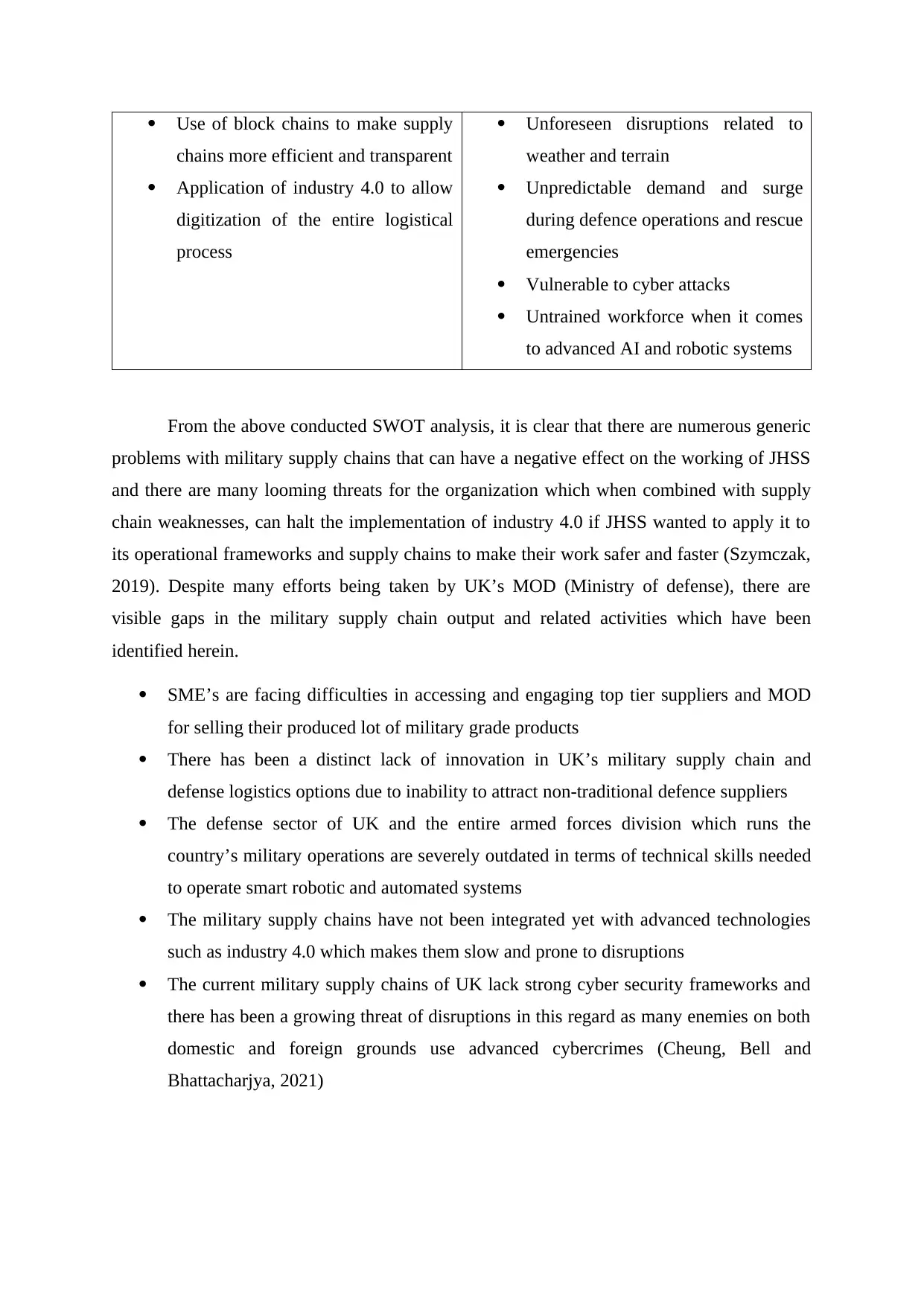
Use of block chains to make supply
chains more efficient and transparent
Application of industry 4.0 to allow
digitization of the entire logistical
process
Unforeseen disruptions related to
weather and terrain
Unpredictable demand and surge
during defence operations and rescue
emergencies
Vulnerable to cyber attacks
Untrained workforce when it comes
to advanced AI and robotic systems
From the above conducted SWOT analysis, it is clear that there are numerous generic
problems with military supply chains that can have a negative effect on the working of JHSS
and there are many looming threats for the organization which when combined with supply
chain weaknesses, can halt the implementation of industry 4.0 if JHSS wanted to apply it to
its operational frameworks and supply chains to make their work safer and faster (Szymczak,
2019). Despite many efforts being taken by UK’s MOD (Ministry of defense), there are
visible gaps in the military supply chain output and related activities which have been
identified herein.
SME’s are facing difficulties in accessing and engaging top tier suppliers and MOD
for selling their produced lot of military grade products
There has been a distinct lack of innovation in UK’s military supply chain and
defense logistics options due to inability to attract non-traditional defence suppliers
The defense sector of UK and the entire armed forces division which runs the
country’s military operations are severely outdated in terms of technical skills needed
to operate smart robotic and automated systems
The military supply chains have not been integrated yet with advanced technologies
such as industry 4.0 which makes them slow and prone to disruptions
The current military supply chains of UK lack strong cyber security frameworks and
there has been a growing threat of disruptions in this regard as many enemies on both
domestic and foreign grounds use advanced cybercrimes (Cheung, Bell and
Bhattacharjya, 2021)
chains more efficient and transparent
Application of industry 4.0 to allow
digitization of the entire logistical
process
Unforeseen disruptions related to
weather and terrain
Unpredictable demand and surge
during defence operations and rescue
emergencies
Vulnerable to cyber attacks
Untrained workforce when it comes
to advanced AI and robotic systems
From the above conducted SWOT analysis, it is clear that there are numerous generic
problems with military supply chains that can have a negative effect on the working of JHSS
and there are many looming threats for the organization which when combined with supply
chain weaknesses, can halt the implementation of industry 4.0 if JHSS wanted to apply it to
its operational frameworks and supply chains to make their work safer and faster (Szymczak,
2019). Despite many efforts being taken by UK’s MOD (Ministry of defense), there are
visible gaps in the military supply chain output and related activities which have been
identified herein.
SME’s are facing difficulties in accessing and engaging top tier suppliers and MOD
for selling their produced lot of military grade products
There has been a distinct lack of innovation in UK’s military supply chain and
defense logistics options due to inability to attract non-traditional defence suppliers
The defense sector of UK and the entire armed forces division which runs the
country’s military operations are severely outdated in terms of technical skills needed
to operate smart robotic and automated systems
The military supply chains have not been integrated yet with advanced technologies
such as industry 4.0 which makes them slow and prone to disruptions
The current military supply chains of UK lack strong cyber security frameworks and
there has been a growing threat of disruptions in this regard as many enemies on both
domestic and foreign grounds use advanced cybercrimes (Cheung, Bell and
Bhattacharjya, 2021)
Paraphrase This Document
Need a fresh take? Get an instant paraphrase of this document with our AI Paraphraser
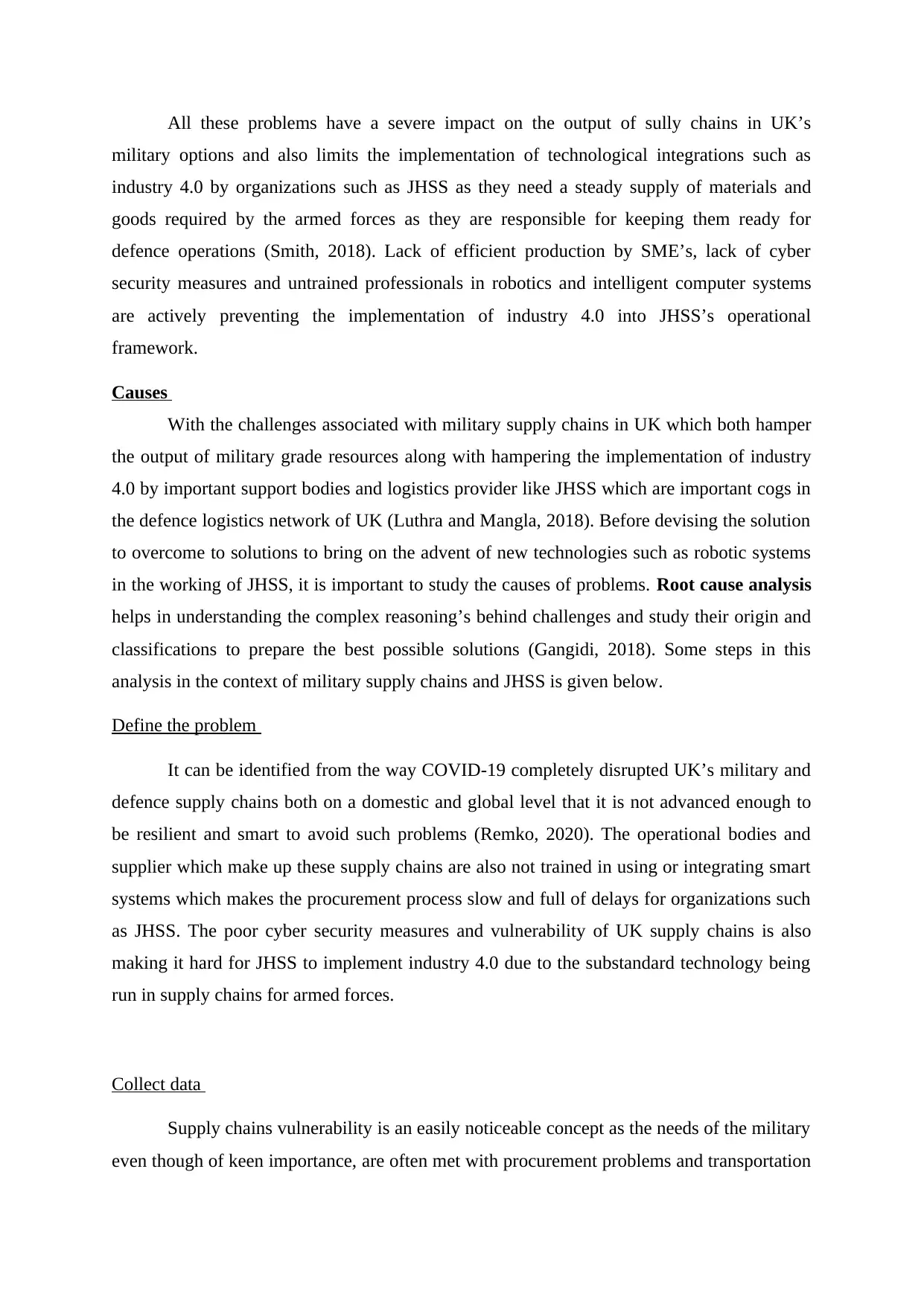
All these problems have a severe impact on the output of sully chains in UK’s
military options and also limits the implementation of technological integrations such as
industry 4.0 by organizations such as JHSS as they need a steady supply of materials and
goods required by the armed forces as they are responsible for keeping them ready for
defence operations (Smith, 2018). Lack of efficient production by SME’s, lack of cyber
security measures and untrained professionals in robotics and intelligent computer systems
are actively preventing the implementation of industry 4.0 into JHSS’s operational
framework.
Causes
With the challenges associated with military supply chains in UK which both hamper
the output of military grade resources along with hampering the implementation of industry
4.0 by important support bodies and logistics provider like JHSS which are important cogs in
the defence logistics network of UK (Luthra and Mangla, 2018). Before devising the solution
to overcome to solutions to bring on the advent of new technologies such as robotic systems
in the working of JHSS, it is important to study the causes of problems. Root cause analysis
helps in understanding the complex reasoning’s behind challenges and study their origin and
classifications to prepare the best possible solutions (Gangidi, 2018). Some steps in this
analysis in the context of military supply chains and JHSS is given below.
Define the problem
It can be identified from the way COVID-19 completely disrupted UK’s military and
defence supply chains both on a domestic and global level that it is not advanced enough to
be resilient and smart to avoid such problems (Remko, 2020). The operational bodies and
supplier which make up these supply chains are also not trained in using or integrating smart
systems which makes the procurement process slow and full of delays for organizations such
as JHSS. The poor cyber security measures and vulnerability of UK supply chains is also
making it hard for JHSS to implement industry 4.0 due to the substandard technology being
run in supply chains for armed forces.
Collect data
Supply chains vulnerability is an easily noticeable concept as the needs of the military
even though of keen importance, are often met with procurement problems and transportation
military options and also limits the implementation of technological integrations such as
industry 4.0 by organizations such as JHSS as they need a steady supply of materials and
goods required by the armed forces as they are responsible for keeping them ready for
defence operations (Smith, 2018). Lack of efficient production by SME’s, lack of cyber
security measures and untrained professionals in robotics and intelligent computer systems
are actively preventing the implementation of industry 4.0 into JHSS’s operational
framework.
Causes
With the challenges associated with military supply chains in UK which both hamper
the output of military grade resources along with hampering the implementation of industry
4.0 by important support bodies and logistics provider like JHSS which are important cogs in
the defence logistics network of UK (Luthra and Mangla, 2018). Before devising the solution
to overcome to solutions to bring on the advent of new technologies such as robotic systems
in the working of JHSS, it is important to study the causes of problems. Root cause analysis
helps in understanding the complex reasoning’s behind challenges and study their origin and
classifications to prepare the best possible solutions (Gangidi, 2018). Some steps in this
analysis in the context of military supply chains and JHSS is given below.
Define the problem
It can be identified from the way COVID-19 completely disrupted UK’s military and
defence supply chains both on a domestic and global level that it is not advanced enough to
be resilient and smart to avoid such problems (Remko, 2020). The operational bodies and
supplier which make up these supply chains are also not trained in using or integrating smart
systems which makes the procurement process slow and full of delays for organizations such
as JHSS. The poor cyber security measures and vulnerability of UK supply chains is also
making it hard for JHSS to implement industry 4.0 due to the substandard technology being
run in supply chains for armed forces.
Collect data
Supply chains vulnerability is an easily noticeable concept as the needs of the military
even though of keen importance, are often met with procurement problems and transportation
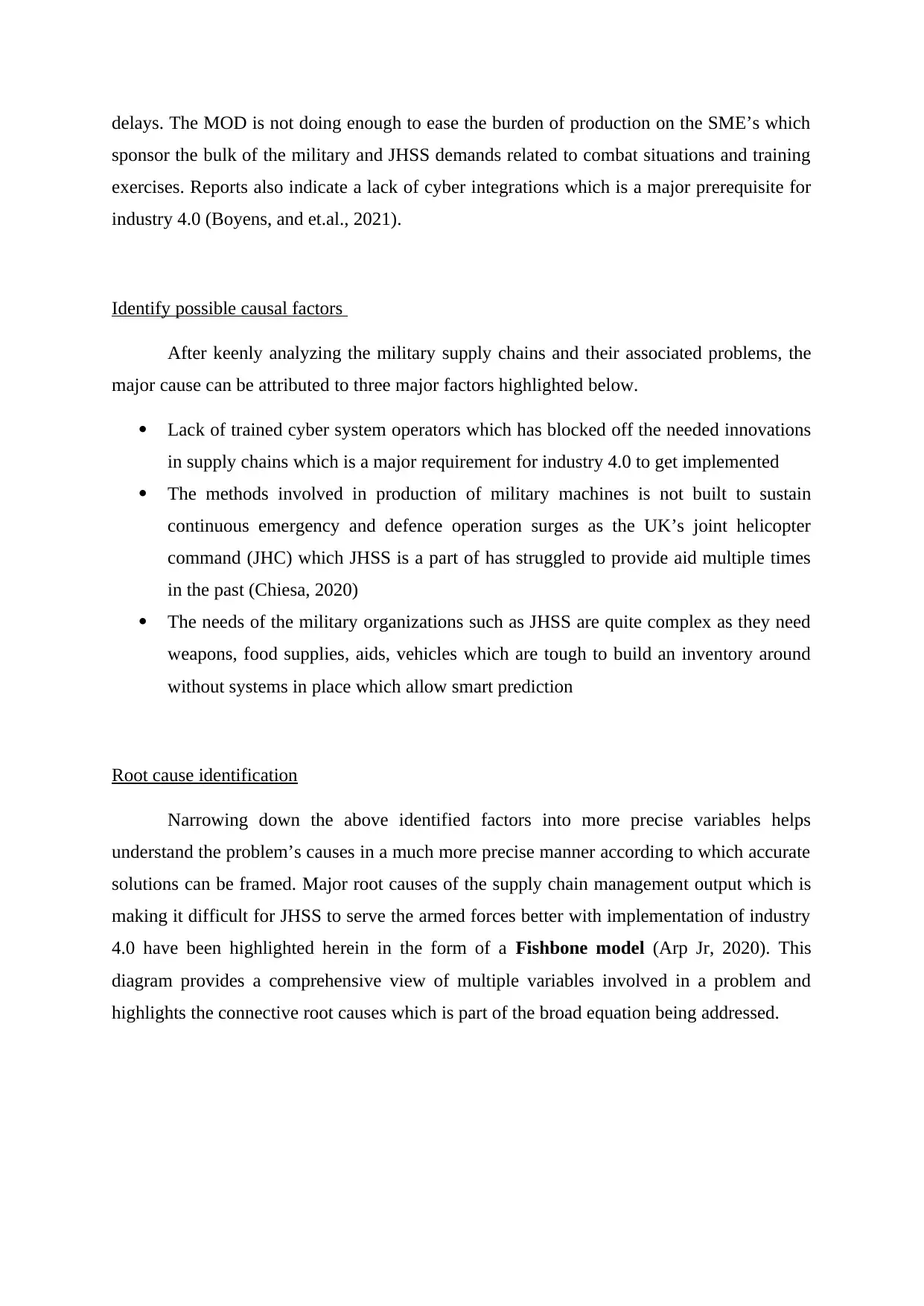
delays. The MOD is not doing enough to ease the burden of production on the SME’s which
sponsor the bulk of the military and JHSS demands related to combat situations and training
exercises. Reports also indicate a lack of cyber integrations which is a major prerequisite for
industry 4.0 (Boyens, and et.al., 2021).
Identify possible causal factors
After keenly analyzing the military supply chains and their associated problems, the
major cause can be attributed to three major factors highlighted below.
Lack of trained cyber system operators which has blocked off the needed innovations
in supply chains which is a major requirement for industry 4.0 to get implemented
The methods involved in production of military machines is not built to sustain
continuous emergency and defence operation surges as the UK’s joint helicopter
command (JHC) which JHSS is a part of has struggled to provide aid multiple times
in the past (Chiesa, 2020)
The needs of the military organizations such as JHSS are quite complex as they need
weapons, food supplies, aids, vehicles which are tough to build an inventory around
without systems in place which allow smart prediction
Root cause identification
Narrowing down the above identified factors into more precise variables helps
understand the problem’s causes in a much more precise manner according to which accurate
solutions can be framed. Major root causes of the supply chain management output which is
making it difficult for JHSS to serve the armed forces better with implementation of industry
4.0 have been highlighted herein in the form of a Fishbone model (Arp Jr, 2020). This
diagram provides a comprehensive view of multiple variables involved in a problem and
highlights the connective root causes which is part of the broad equation being addressed.
sponsor the bulk of the military and JHSS demands related to combat situations and training
exercises. Reports also indicate a lack of cyber integrations which is a major prerequisite for
industry 4.0 (Boyens, and et.al., 2021).
Identify possible causal factors
After keenly analyzing the military supply chains and their associated problems, the
major cause can be attributed to three major factors highlighted below.
Lack of trained cyber system operators which has blocked off the needed innovations
in supply chains which is a major requirement for industry 4.0 to get implemented
The methods involved in production of military machines is not built to sustain
continuous emergency and defence operation surges as the UK’s joint helicopter
command (JHC) which JHSS is a part of has struggled to provide aid multiple times
in the past (Chiesa, 2020)
The needs of the military organizations such as JHSS are quite complex as they need
weapons, food supplies, aids, vehicles which are tough to build an inventory around
without systems in place which allow smart prediction
Root cause identification
Narrowing down the above identified factors into more precise variables helps
understand the problem’s causes in a much more precise manner according to which accurate
solutions can be framed. Major root causes of the supply chain management output which is
making it difficult for JHSS to serve the armed forces better with implementation of industry
4.0 have been highlighted herein in the form of a Fishbone model (Arp Jr, 2020). This
diagram provides a comprehensive view of multiple variables involved in a problem and
highlights the connective root causes which is part of the broad equation being addressed.
⊘ This is a preview!⊘
Do you want full access?
Subscribe today to unlock all pages.

Trusted by 1+ million students worldwide
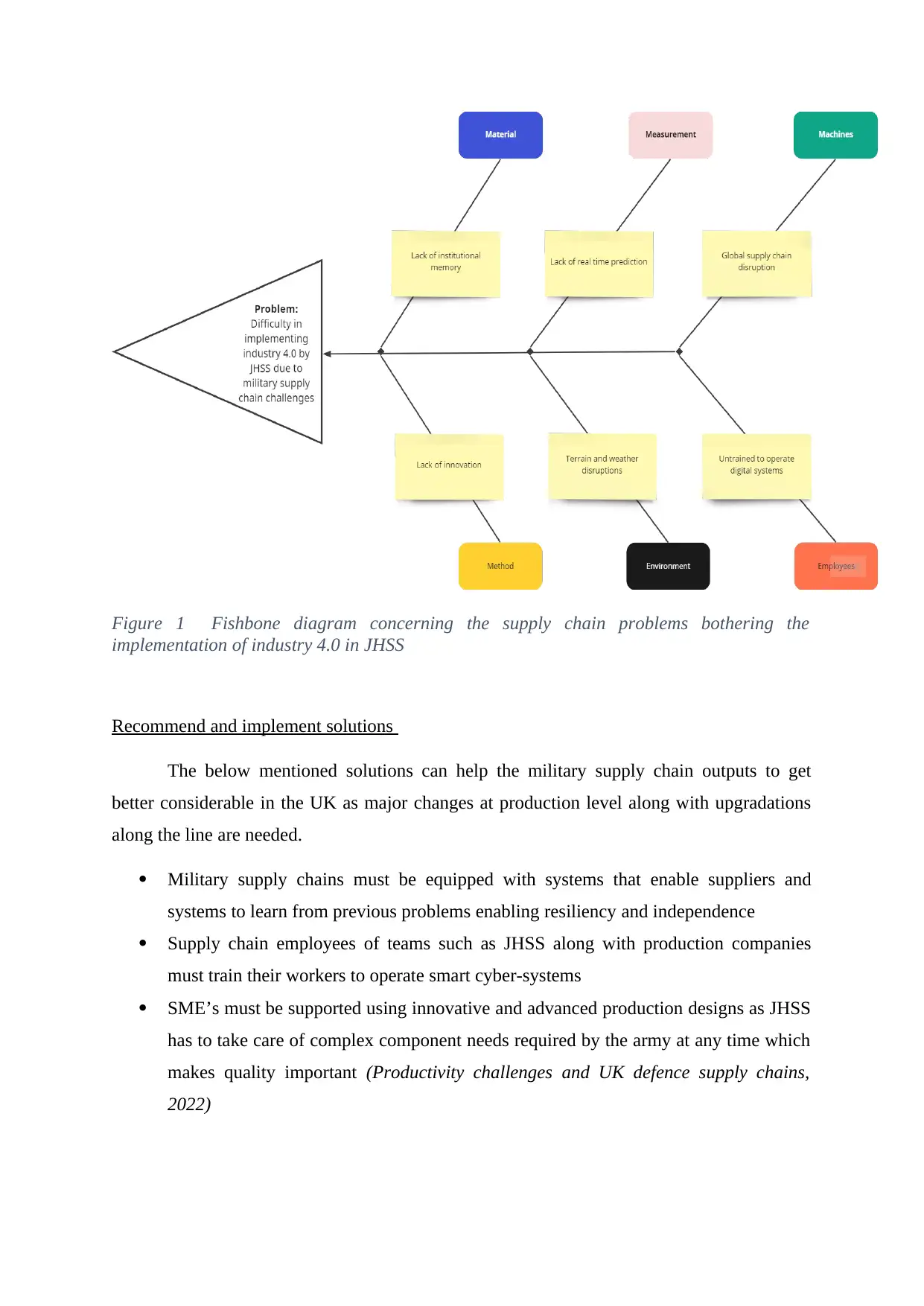
Figure 1 Fishbone diagram concerning the supply chain problems bothering the
implementation of industry 4.0 in JHSS
Recommend and implement solutions
The below mentioned solutions can help the military supply chain outputs to get
better considerable in the UK as major changes at production level along with upgradations
along the line are needed.
Military supply chains must be equipped with systems that enable suppliers and
systems to learn from previous problems enabling resiliency and independence
Supply chain employees of teams such as JHSS along with production companies
must train their workers to operate smart cyber-systems
SME’s must be supported using innovative and advanced production designs as JHSS
has to take care of complex component needs required by the army at any time which
makes quality important (Productivity challenges and UK defence supply chains,
2022)
implementation of industry 4.0 in JHSS
Recommend and implement solutions
The below mentioned solutions can help the military supply chain outputs to get
better considerable in the UK as major changes at production level along with upgradations
along the line are needed.
Military supply chains must be equipped with systems that enable suppliers and
systems to learn from previous problems enabling resiliency and independence
Supply chain employees of teams such as JHSS along with production companies
must train their workers to operate smart cyber-systems
SME’s must be supported using innovative and advanced production designs as JHSS
has to take care of complex component needs required by the army at any time which
makes quality important (Productivity challenges and UK defence supply chains,
2022)
Paraphrase This Document
Need a fresh take? Get an instant paraphrase of this document with our AI Paraphraser
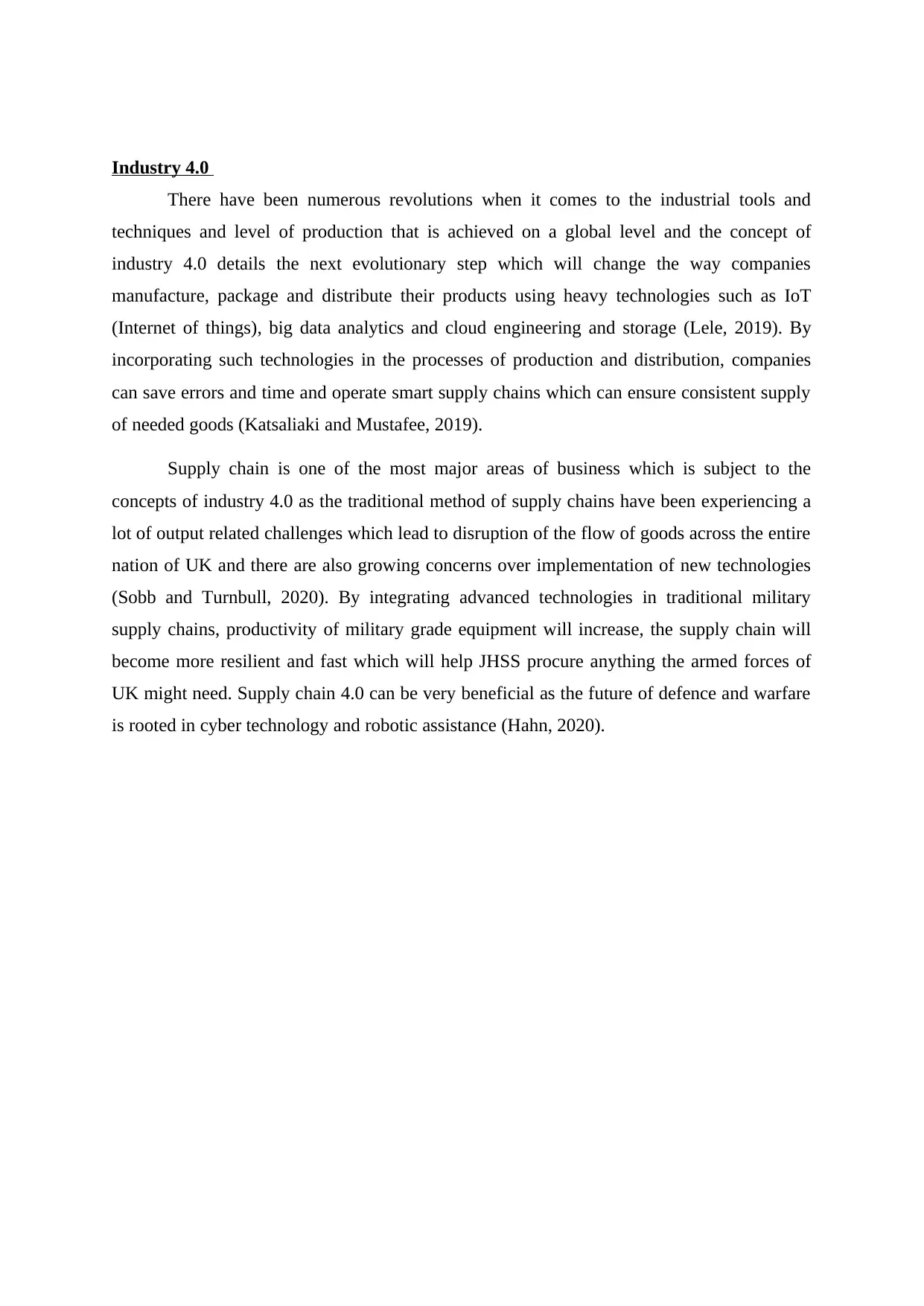
Industry 4.0
There have been numerous revolutions when it comes to the industrial tools and
techniques and level of production that is achieved on a global level and the concept of
industry 4.0 details the next evolutionary step which will change the way companies
manufacture, package and distribute their products using heavy technologies such as IoT
(Internet of things), big data analytics and cloud engineering and storage (Lele, 2019). By
incorporating such technologies in the processes of production and distribution, companies
can save errors and time and operate smart supply chains which can ensure consistent supply
of needed goods (Katsaliaki and Mustafee, 2019).
Supply chain is one of the most major areas of business which is subject to the
concepts of industry 4.0 as the traditional method of supply chains have been experiencing a
lot of output related challenges which lead to disruption of the flow of goods across the entire
nation of UK and there are also growing concerns over implementation of new technologies
(Sobb and Turnbull, 2020). By integrating advanced technologies in traditional military
supply chains, productivity of military grade equipment will increase, the supply chain will
become more resilient and fast which will help JHSS procure anything the armed forces of
UK might need. Supply chain 4.0 can be very beneficial as the future of defence and warfare
is rooted in cyber technology and robotic assistance (Hahn, 2020).
There have been numerous revolutions when it comes to the industrial tools and
techniques and level of production that is achieved on a global level and the concept of
industry 4.0 details the next evolutionary step which will change the way companies
manufacture, package and distribute their products using heavy technologies such as IoT
(Internet of things), big data analytics and cloud engineering and storage (Lele, 2019). By
incorporating such technologies in the processes of production and distribution, companies
can save errors and time and operate smart supply chains which can ensure consistent supply
of needed goods (Katsaliaki and Mustafee, 2019).
Supply chain is one of the most major areas of business which is subject to the
concepts of industry 4.0 as the traditional method of supply chains have been experiencing a
lot of output related challenges which lead to disruption of the flow of goods across the entire
nation of UK and there are also growing concerns over implementation of new technologies
(Sobb and Turnbull, 2020). By integrating advanced technologies in traditional military
supply chains, productivity of military grade equipment will increase, the supply chain will
become more resilient and fast which will help JHSS procure anything the armed forces of
UK might need. Supply chain 4.0 can be very beneficial as the future of defence and warfare
is rooted in cyber technology and robotic assistance (Hahn, 2020).
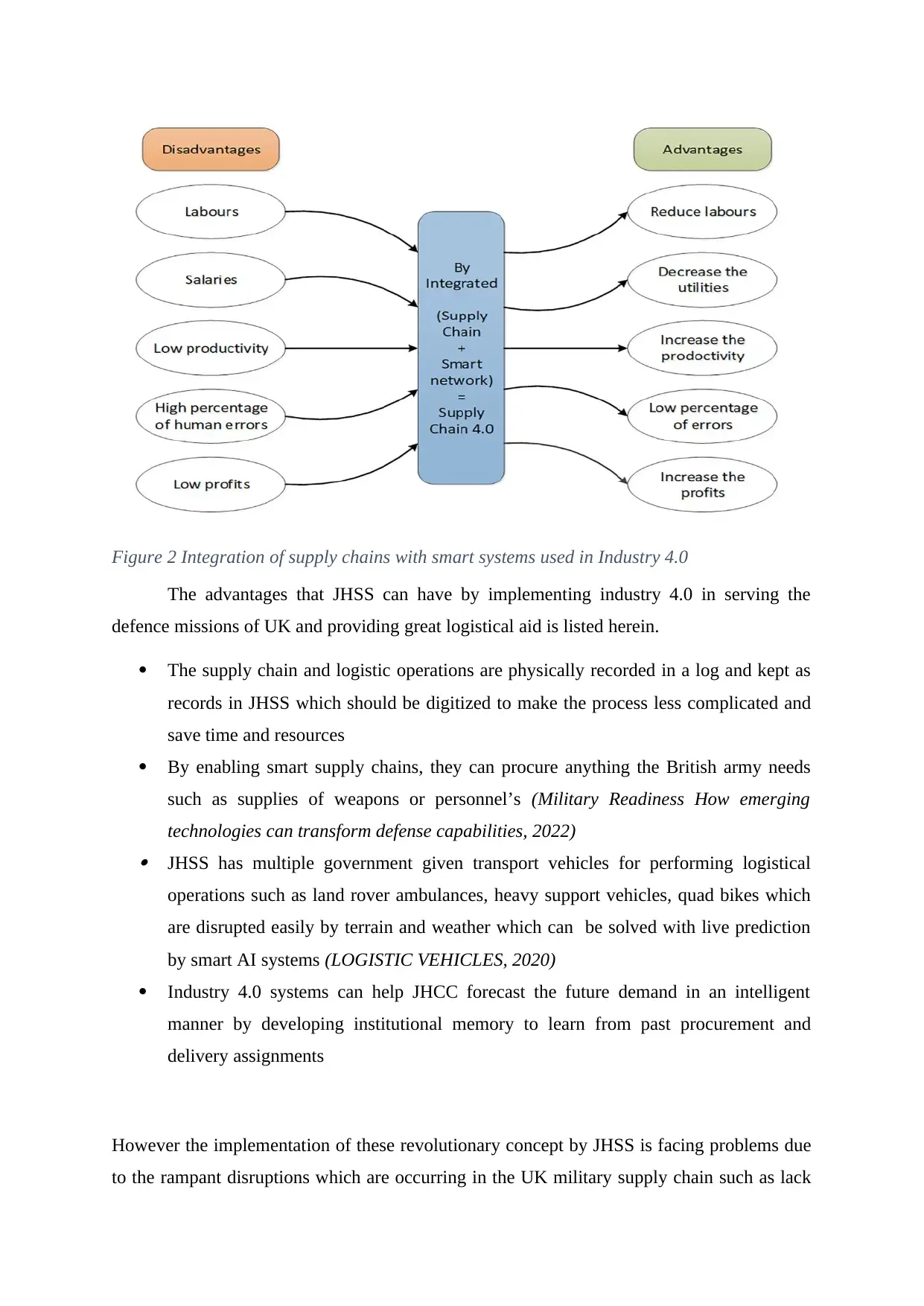
Figure 2 Integration of supply chains with smart systems used in Industry 4.0
The advantages that JHSS can have by implementing industry 4.0 in serving the
defence missions of UK and providing great logistical aid is listed herein.
The supply chain and logistic operations are physically recorded in a log and kept as
records in JHSS which should be digitized to make the process less complicated and
save time and resources
By enabling smart supply chains, they can procure anything the British army needs
such as supplies of weapons or personnel’s (Military Readiness How emerging
technologies can transform defense capabilities, 2022) JHSS has multiple government given transport vehicles for performing logistical
operations such as land rover ambulances, heavy support vehicles, quad bikes which
are disrupted easily by terrain and weather which can be solved with live prediction
by smart AI systems (LOGISTIC VEHICLES, 2020)
Industry 4.0 systems can help JHCC forecast the future demand in an intelligent
manner by developing institutional memory to learn from past procurement and
delivery assignments
However the implementation of these revolutionary concept by JHSS is facing problems due
to the rampant disruptions which are occurring in the UK military supply chain such as lack
The advantages that JHSS can have by implementing industry 4.0 in serving the
defence missions of UK and providing great logistical aid is listed herein.
The supply chain and logistic operations are physically recorded in a log and kept as
records in JHSS which should be digitized to make the process less complicated and
save time and resources
By enabling smart supply chains, they can procure anything the British army needs
such as supplies of weapons or personnel’s (Military Readiness How emerging
technologies can transform defense capabilities, 2022) JHSS has multiple government given transport vehicles for performing logistical
operations such as land rover ambulances, heavy support vehicles, quad bikes which
are disrupted easily by terrain and weather which can be solved with live prediction
by smart AI systems (LOGISTIC VEHICLES, 2020)
Industry 4.0 systems can help JHCC forecast the future demand in an intelligent
manner by developing institutional memory to learn from past procurement and
delivery assignments
However the implementation of these revolutionary concept by JHSS is facing problems due
to the rampant disruptions which are occurring in the UK military supply chain such as lack
⊘ This is a preview!⊘
Do you want full access?
Subscribe today to unlock all pages.

Trusted by 1+ million students worldwide
1 out of 20
Your All-in-One AI-Powered Toolkit for Academic Success.
+13062052269
info@desklib.com
Available 24*7 on WhatsApp / Email
![[object Object]](/_next/static/media/star-bottom.7253800d.svg)
Unlock your academic potential
Copyright © 2020–2025 A2Z Services. All Rights Reserved. Developed and managed by ZUCOL.

